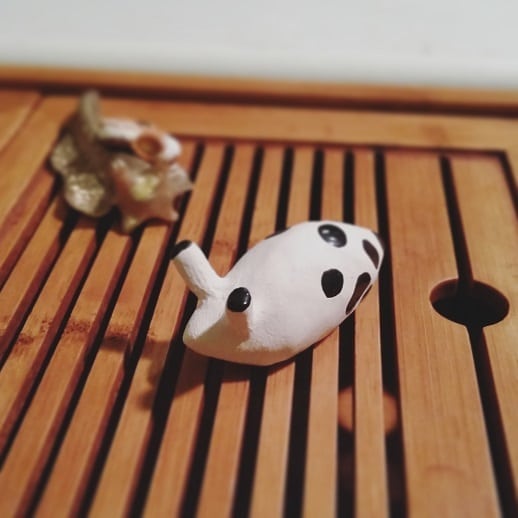A Korean Tea Coin and a Firepit
A “steep story” by Geoffrey F. Norman
Dokk-cha (or “Tteok-cha, as I like to call it) is a type of pressed tea from Korea. If you’ve been following along in my latest exploits, you will recall I made mention of it in my Canadian-Burlington tea-picking adventure. Pedro Villalon of O5 Tea was kind enough to gift me with one of these coins. Learning what to do with it was going to be a challenge.

Image Owned by the Cha Dao Blog
I first learned of dokk-cha through the ever-resourceful Gongfu Girl blog. They’d had an experience with some of these tea coins at the Phoenix Tea shop and provided an anecdotal how-to on their preparation. In addition to that, she provided another article posted in Cha Dao (written by Steven Owyoung) about the history of dokk-cha. The word “dokk” is actually an onomonopia referring to both the compression technique used for the tea leaves involved…as well as the sound they make.
Many foodstuffs used to be duly…uh…dokk’d, besides tea leaves. Rice was a common one back in the hither and yon. The making of dokk-cha, unfortunately, fell out of favor during and after the Japanese occupation of South Korea – until recently. Monks, tea farmers, or anyone with a wacky idea have been reviving the age-old technique.
The process for making dokk-cha – unlike other compressed teas like pu-erh – is labor intensive but rather simple. Tea leaves are steamed in an earthenware pot, then taken out once softened. Then they’re given a beating via a mortar and pestle until they become a nice, green paste. Said mulch is then pressed (or dokk’d) into the shape of a coin, or whatever the presser wishes.
The ideal way of brewing a pressed tea coin is to lightly roast it over burning olive pit charcoal. Such specialty charcoal is hard to come by outside of Asia Major, but any ol’ charcoal could be substituted. The roasting takes fifteen minutes, or until the coin is pliable. After that, you place the coin in a pot of water over a stove (on a low simmer), and brew it for three-and-a-half hours.
I didn’t have olive pit charcoal. Or a charcoal stove of any sort. Nor did I have chopsticks, tongs, or whatever else to hold the coin in place. What I did have was a brother…
Who made his own firepit.

Close enough.
Unfortunately, he didn’t have any chopsticks to use as a pair of tongs. However, the substitute suggestion was far better – skewers! I asked him what the skewers were used for prior to fitting the coin on one.
His response was, “Uh…tofurky?”
I left that alone.
Over the course of fifteen minutes, I sat in a chair as my brother added whatever kindling he could to the pit. For a man about to get married, he had quite a bit of wood in the backyard to provide for said cause. Ever the do-it-yourselfer, my brother.
As I waved the coin over the flame, there were a couple of times where I didn’t watch what I was doing. Flame occasionally licked the coin itself. I’d heard that was supposed to be avoided. Once fifteen minutes had passed, I looked at the coin. Part of it was lightly smoking. Oops.

I took a whiff.
For lack of a better comparison, all I can say is that it smelled like a reefer madness. Roasty, yes. But very cannabis-like. I gave a nervous smile and motioned us over to the second phase – the simmering and long wait. Bro took out a pot, and put the stove on the lowest setting. I plopped the coin in and monitored the progress of the brew every forty-five minutes or so.
On a couple of occasions, I took the lid off the pot to get a good look-‘n-sniff. The water was darkening nicely – a very even, broth-like darkness. The aroma was…hard to describe. At one moment it reminded me of a roasted Dong Ding. On another, later whiff it resembled a Ti Kwan Yin. Very peculiar.

In the interim, my brother and his fiancée were entertaining guests. I tried to stay out of their way as my experiment manifested. They did, however, coax me out of hiding with a sweet potato veggie burger and gelato. I can never say “no” to gelato.
At the three-and-a-half-hour mark, I turned off the simmer, and – with my brother’s permission – poured the soup-like liquor into his French press. The liquor was very shou pu-erh-like in appearance, but the aroma reminded me of a very ancient Taiwanese oolong.

The entire time, my brother kept the firepit stoked. We all gathered around it – them with their beers and juices, and me with my unusual tea. I sipped it gingerly. That aged oolong comparison? Even more accurate in the flavor. This tasted like a tea decades beyond its years – medicinal, kinda floral, mildly roasty, and with maybe a hint of fruit. Somewhere.

Did I do the process correctly? Did it taste like how it was supposed to? Heck if I know.
As my brother said, “It’s good…but not three-hours good.”
I flatly disagreed. I felt like a fisherman, and the flames of the firepit were my sea. And all I had for bait was a very unusual tea.









